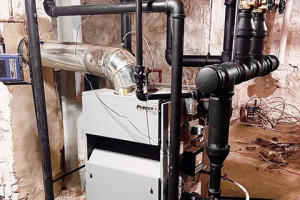
Hello, old friend. I’m writing today to say thanks, and to say farewell. This will be my last column.

In 1885, when you could still buy a milk cow for $29.70, Albert Butz, a Swiss immigrant living in St. Paul, Minnesota, invented what he called the damper-flapper. He patented it the following year. The flapper opened a damper that allowed outside air to enter a coal-fired home furnace. This increased the oxygen in the furnace and made the fire burn hotter. When the temperature rose to a desired point, the damper closed.
And as simple as that was, the damper-flapper would be the parent of what we came to call the thermostat.
Mr. Butz formed the Butz Thermo-Electric Regulator Company in Minneapolis the following year, but then, for no apparent reason, he left the business two years later but hung on to the damper-flapper patent.
Andrew Robbins took over the company in 1888 and renamed it the Consolidated Temperature Controlling Company. William. R. Sweatt, a Minneapolis businessman, joined the company and by 1900, he owned all of it. By then, and proving that it’s not easy to choose just the right name, the company became the Electric Heat Regulator Company. But not long after, and to clear up some confusion, they further defined the business as the Minneapolis Heat Regulator Company. Whew!
But hang on; we’re not quite done yet. Mark Honeywell’s plumbing company, which was producing neat hydronic gizmos, merged with Minneapolis Heat Regulator and together they became (wait for it. . . ) Minneapolis Honeywell! And this marriage is what eventually led to the gorgeous roundness of the Honeywell T87 thermostat.
I was reminiscing with friends about that ubiquitous, and now out-of-production (thanks to the evils of mercury) product, and wondering if anyone missed it, especially considering all those smart thermostats we now have.
A gent from Illinois said, “Miss the T87? No! I never got to touch it. I don't remember a time growing up when I was allowed to adjust that thing. It was a mystery to me. They had no problem letting me do all kinds of dangerous things at a young age, but the round, golden thermostat, located in the hallway, was only to be adjusted by a parent. This was non-negotiable.
“When I was in college and got an apartment, it had the same thermostat. I thought I was now in control of the heat and air conditioning, but nope. The then-girlfriend and I were, as she explained years later when she took a lot of my money, most of my self-esteem and what little pride I had left, ‘thermally incompatible.’ There were (many) other reasons for her leaving, but that one was my favorite. So no, Dan, I do not miss the T87.”
Ahh, thermostats and relationships. What can any of us say?
A friend in Connecticut chirped in. “Miss it? How can you miss something you still use? There are four of them around here, all in use. They do exactly what they are supposed to do, when they’re supposed to do it. There’s no fuss. What's not to like? Three of them are fairly recent. I’d say from five- to 20 years ago. The fourth one is maybe 60 years old?”
While working for a manufacturers’ rep years back, I spent a happy Saturday installing a T87 in each of the Accountant Department’s cubicles. There was no need for wiring because the baseboard radiators had thermostatic radiator valves that no one in Accounting could understand because the knobs read, 1, 2, 3, 4, and 5, rather than degrees Fahrenheit.
The following Monday, everyone was delighted and thermally compatible because everyone was in full control of their unwired T87.
Jeffrey L. Rodengen wrote a Honeywell company history in 1995 (The “Legend of Honeywell”) and revealed that the company sold about a million T87 thermostats each year. They called it The Round, and in 1997, the T87 was in an exhibition at the Smithsonian Institution's Cooper-Hewitt National Design Museum in New York City. It remains part of the Smithsonian's collection, right up there with Dorothy’s red shoes and Fonzi’s leather jacket. How about that?
But the T87 has never been able to compete well with beer. I know this because a buddy in Chicago told me so.
“In the early 1980s, I was on a service call for no cooling. I was following up on another of our techs, who had been there earlier that day to replace the thermostat. The homeowner asked for a different guy this time. He said the first guy seemed ‘a bit off.’
“I walked over to the thermostat and noticed that the word Honeywell was upside-down. The other guy mounted it that way, which meant that the sub-base was also upside down. I had to call it in and explain that I had spun it 180 degrees, and all was well now.
“The other guy got called back to the shop and they checked his breath and then his van. He had a cooler filled with Old Style beer between the seats. The empty cans, well, he just tossed those into the back with the rest of his tools. That, of course, was his last day.”
Another friend commented, “You know, 50 years from now I doubt if there will be a conversation like this about smart thermostats. My parents still have a T87 in their house. It was there when they bought the place in 1985. They replaced the converted-to-gas-from-coal, octopus furnace, but my Dad didn't want to get rid of the thermostat. They only replaced that replacement furnace last year and they still kept the old T87.”
Isn’t that remarkable? The thing deserves to be in the Smithsonian.
And then a man who is much smarter than I am had this to say:
“Those old bimetals that were in the original Honeywells were really majestic on the wall of any home. They did have two problems, though, both of which the mercury-bulb units solved. The worst problem was that, with time, the bimetal contracts would become damaged in various ways and the operation became erratic. The other problem was that they depended on a relatively short bimetal element, and a somewhat problematic arrangement for anticipation, with the result that they were none too precise.
“The mercury bulb concept was, and remains, revolutionary. Here we have a partially vacuum-sealed bulb. The liquid mercury wets the terminals without wear or oxidation. The switching action remains reliable for hundreds of thousands of cycles. It's limited only by fatigue in the connecting wires. Further, with a calibrated weight of mercury in the bulb, the dead band between on and off is entirely predictable and dependent on the spring properties. In a thermostat, that spring is the bimetal’s sensing coil and can be quite long and have very predictable properties.
“The only real downside is that the thermostat has to be carefully leveled (right side up!) to be accurate. Sloppy workmanship will not do. The unrealistic downside is that somehow the general public became terrified of mercury, and the mercury switch got banned.”
Let’s finish with this delicious T87 memory from a retired gent that speaks of the trade as it once was.
“When I got out of Tech school in 1968 and started with a now-gone HVAC company, the head service tech said that I had to learn how to install a T87 on a white plaster wall with dirty fingers and not put any mark on that wall. He had a vertical test board that he made up with a piece of drywall that he could replace as necessary. He handed me a new T87 and sub-base and told me to install it on his test board, but first I had to wipe carbon black on my fingertips. He said that I had to be able to mount the T87 and leave no marks on the wall if I wanted to keep my job.”
To which another guy responded, “I hope that when you pulled a pair of gloves out of your pocket you were offered a raise on the spot.”
I miss a lot of things these days. The T87 is just one of them.

Hello, old friend. I’m writing today to say thanks, and to say farewell. This will be my last column.

My six-year-old grandboy, Brendan, was in the vestibule of the diner when the bubblegum machine caught his attention. It was one of those spiral models that appeared in t...

Subdural posed a question on The Wall at HeatingHelp.com in the Strictly Steam section, where some of the sharpest knives in the drawer post every day. The question was a...